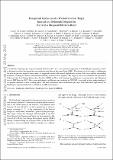| dc.contributor.author | Lee, S. | |
| dc.contributor.author | Corliss, Ross Cameron | |
| dc.contributor.author | Friščic, I. | |
| dc.contributor.author | Balewski, Jan T. | |
| dc.contributor.author | Bernauer, Jan Christopher | |
| dc.contributor.author | Epstein, Charles S. | |
| dc.contributor.author | Fisher, P. | |
| dc.contributor.author | Hasell, Douglas K. | |
| dc.contributor.author | Johnston, R | |
| dc.contributor.author | Milner, Richard G | |
| dc.contributor.author | Moran, P | |
| dc.contributor.author | Palumbo, Daniel C. | |
| dc.contributor.author | Steadman, Stephen G | |
| dc.contributor.author | Vogel, C. | |
| dc.contributor.author | Wang, Y. | |
| dc.date.accessioned | 2022-09-12T20:22:08Z | |
| dc.date.available | 2021-09-20T18:22:21Z | |
| dc.date.available | 2022-09-12T20:22:08Z | |
| dc.date.issued | 2019 | |
| dc.identifier.uri | https://hdl.handle.net/1721.1/132431.2 | |
| dc.description.abstract | © 2019 Elsevier B.V. A windowless hydrogen gas target of nominal thickness 1019 cm−2 is an essential component of the DarkLight experiment, which is designed to utilize the megawatt electron beam at an Energy Recovery Linac (ERL). The design of such a target is challenging because the pressure drops by many orders of magnitude between the central, high-density section of the target and the surrounding beamline, resulting in laminar, transitional, and finally molecular flow regimes. The target system was assembled and operated at Jefferson Lab's Low Energy Recirculator Facility (LERF) in 2016, and subsequently underwent several revisions and calibration tests at MIT Bates in 2017. The system at dynamic equilibrium was simulated in COMSOL to provide a better understanding of its optimal operation at other working points. We have determined that a windowless gas target with sufficiently high density for DarkLight's experimental needs is feasible in an ERL environment. | en_US |
| dc.language.iso | en | |
| dc.publisher | Elsevier BV | en_US |
| dc.relation.isversionof | 10.1016/J.NIMA.2019.05.071 | en_US |
| dc.rights | Creative Commons Attribution-NonCommercial-NoDerivs License | en_US |
| dc.rights.uri | http://creativecommons.org/licenses/by-nc-nd/4.0/ | en_US |
| dc.source | arXiv | en_US |
| dc.title | Design and operation of a windowless gas target internal to a solenoidal magnet for use with a megawatt electron beam | en_US |
| dc.type | Article | en_US |
| dc.contributor.department | Massachusetts Institute of Technology. Laboratory for Nuclear Science | en_US |
| dc.contributor.department | Massachusetts Institute of Technology. Department of Physics | en_US |
| dc.relation.journal | Nuclear Instruments and Methods in Physics Research, Section A: Accelerators, Spectrometers, Detectors and Associated Equipment | en_US |
| dc.eprint.version | Author's final manuscript | en_US |
| dc.type.uri | http://purl.org/eprint/type/JournalArticle | en_US |
| eprint.status | http://purl.org/eprint/status/PeerReviewed | en_US |
| dc.date.updated | 2020-10-21T17:35:10Z | |
| dspace.orderedauthors | Lee, S; Corliss, R; Friščić, I; Alarcon, R; Aulenbacher, S; Balewski, J; Benson, S; Bernauer, JC; Bessuille, J; Boyce, J; Coleman, J; Douglas, D; Epstein, CS; Fisher, P; Frierson, S; Garçon, M; Grames, J; Hasell, D; Hernandez-Garcia, C; Ihloff, E; Johnston, R; Jordan, K; Kazimi, R; Kelsey, J; Kohl, M; Liyanage, A; McCaughan, M; Milner, RG; Moran, P; Nazeer, J; Palumbo, D; Poelker, M; Randall, G; Steadman, SG; Tennant, C; Tschalär, C; Vidal, C; Vogel, C; Wang, Y; Zhang, S | en_US |
| dspace.date.submission | 2020-10-21T17:35:34Z | |
| mit.journal.volume | 939 | en_US |
| mit.license | PUBLISHER_CC | |
| mit.metadata.status | Publication Information Needed | en_US |
